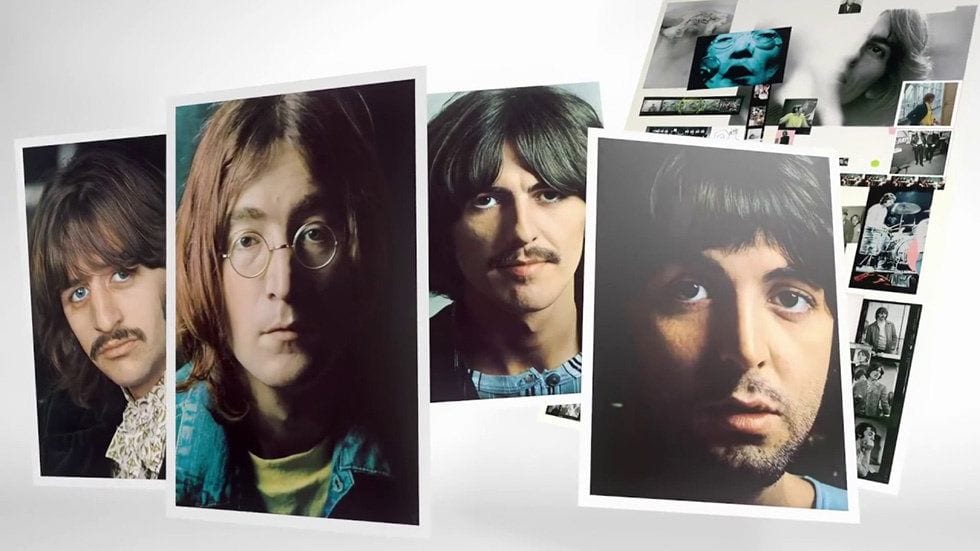Ciccone Youth – The Whitey Album

The experimental New York outfit Sonic Youth exhibited their own preoccupation with the subversive qualities of the White Album when they temporarily morphed into Ciccone Youth and released the Whitey Album in January 1989, on the independent Enigma Records label. They forged the record out of a highly ambitious plan to cover the Beatles’ double LP in its entirety, in their ongoing mission to defy musical boundaries and redefine guitar music.
Stevie Chick has noted, on this point, that because the White Album was “by turns as ugly, noisy, sweet, sad and weird as the Beatles ever got”, it was “certainly worthy material for interpretation via Sonic Youth’s transmogrifying guitars” (Psychic Confusion: The Sonic Youth Story, 2008). In the end, though, the band simply adopted the White Album archetype as a method of engaging in hip-hop-style experimentation as part of a side project in tribute to pop-queen Madonna (Ciccone).
The core of Ciccone Youth, namely Thurston Moore, Kim Gordon, Steve Shelly, and Lee Ranaldo, highlighted the deliberately fractured nature of the Whitey Album by releasing it in the maelstrom of critical success surrounding their fifth studio LP, Daydream Nation (1988), a double album of 12 tracks that actually blurred together and culminated in a unified “Trilogy”. They, therefore, offset their breakthrough moment with a completely uncommercial venture based upon studio improvisation and lo-fi production. They enlisted ex-Minutemen bassist Mike Watt to help out, and their only bow to music-business orthodoxy was to include on it an earlier single, from September ’86, a dirty though an accessible version of the Madonna chart favorite, “Into The Groove” (retitled “Into The Groovy”), not that this was an actual hit.
The band followed McCartney’s example on “Wild Honey Pie” and “Why Don’t We Do It In The Road?” of improvising much of the material on the Whitey Album in the studio. They did this by incorporating the creative techniques of contemporary black artists like Tupac Shakur, the Notorious B.I.G., and NWA, recognizing hip-hop as the true language of subversion at this point, especially in the wake of Straight Outta Compton (1988) and its centerpiece “Fuck Tha Police”.
Kim Gordon has stated: “The four of us decided to do a record where you simply went into the studio and made it there, the way hip-hop is made” (Girl in a Band: A Memoir, 2015). In this manner, they produced a work marked by the metamorphosizing methods of drum machines, sampling, beatboxing, and freestyle rapping, which went a long way to undermine preconceived ideas and expectations of a rock album, while providing a parody of the ’80s pop scene.
The band defied convention on the Whitey Album, first of all, with two minutes of tribal rhythm, followed by a minute of total silence, ahead of a cover version of Madonna’s “Burnin’ Up” (from her first album), and then a track fairly accurately titled “Two Cool Rock Chicks Listening To Neu”. They further provided a deconstruction of Robert Palmer’s “Addicted to Love” that featured a karaoke-style vocal from Gordon, while the undoubted peak was “Macbeth”, a heavy and sinister instrumental piece.
They also seemed to take most inspiration from the Beatles’ “Revolution 9” in all of this, in accord with its eight unsettling minutes of improvised noise comprising spoken-word extracts, sound effects, stereo panning, and tape loops fading in and out, the product of Lennon’s engagement with the avant-garde world of John Cage and Karlheinz Stockhausen, by way of performance artist (and new partner) Yoko Ono. “Platoon II”, for instance, is a scary noise collage over a hip-hop beat, while “Hendrix/Cosby” is a tuneless jam based around a looped sample from a rare Jimi Hendrix performance. “Silence”, on the other hand, is likely a tongue-in-cheek homage to Cage’s “4.33”, a three-movement composition of — basically — silence.
In further deference to the White Album, J Mascis of Dinosaur Jr stepped in on lead-guitar duty halfway through “Two Rock Chicks”, very much in the spirit of Eric Clapton on the George Harrison standout “While My Guitar Gently Weeps”. The band also made the reverse sleeve of the record pure white with black type, in imitation of the simple yet iconic design of the 1968 LP (the front cover being, naturally, a close-up of Ms. Ciccone’s face). However, for all its Beatles-inspired mayhem, the record didn’t make a huge impact on its release, many viewing it as (that word) self-indulgent. Neither can it be seen today as a particular landmark in alt-rock, its success, instead, lying in the way it broadened the palette of the movement immeasurably.
- The White Album: Side Three - PopMatters
- The Beatles: White Album - Side 2 - PopMatters
- Birthday: The White Album Turns 40 - PopMatters
- The White Album: Side One - PopMatters
- The Beatle's White Album
- The White Album: Side Three - PopMatters
- The White Album: Side Four - PopMatters
- Birthday: The Beatles' White Album 40th Anniversary
- Counterbalance No. 14: The Beatles' 'The Beatles' AKA "The White ...
- The Glorious, Quixotic Mess That Is the Beatles' 'White Album ...
- Riotous and Hushed: The Beatles' 'The White Album' - PopMatters
- Kristin Hersh Discusses Her Gutsy New Throwing Muses Album - PopMatters

